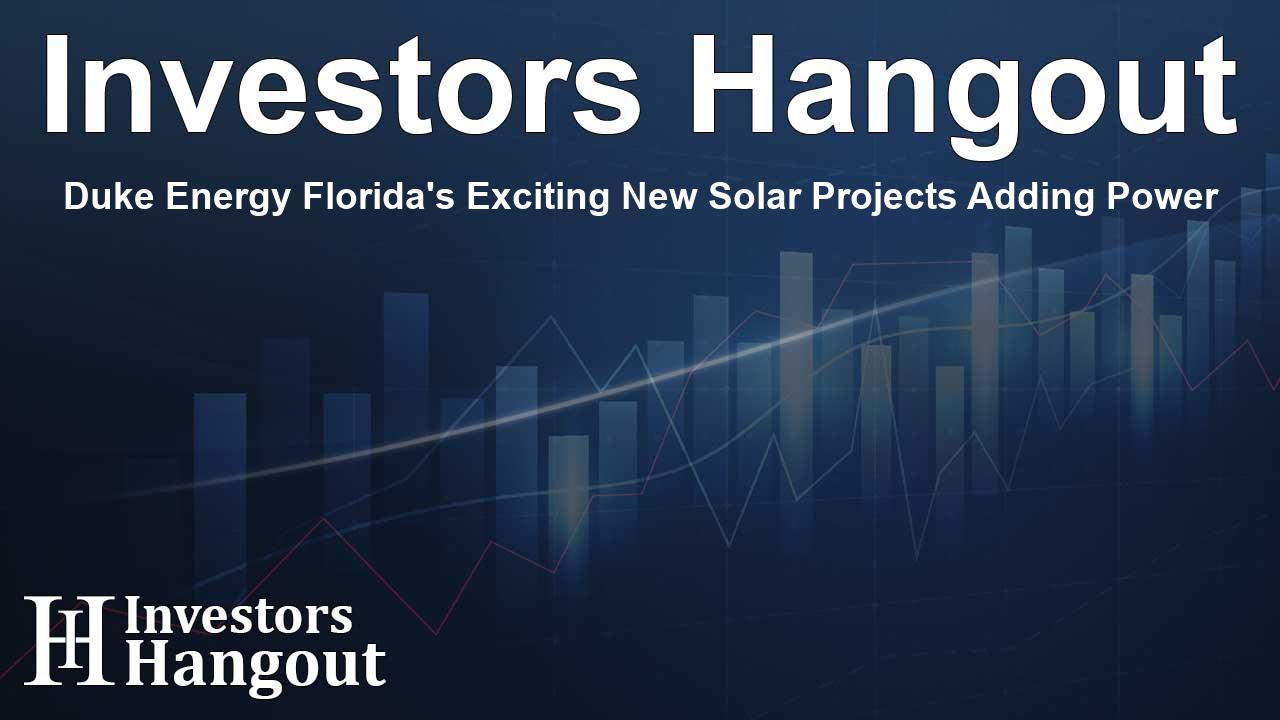Duke Energy Florida's Exciting New Solar Projects Adding Power

Duke Energy Florida Unveils Plans for New Solar Initiatives
Duke Energy Florida has announced plans to develop four new solar energy sites aimed at enriching the region's electric grid. This initiative, designed to underscore the commitment to clean and reliable energy solutions, is expected to add nearly 300 megawatts of renewable energy to the grid.
Significant Customer Savings Ahead
The collective benefits from these newly planned solar installations are impressive. It is projected that customers will see an astonishing total savings of $843 million throughout the lifetime of these solar projects. Such savings not only reflect financial advantages but also highlight the importance of transitioning towards sustainable energy sources.
Locations and Development Timeline
As part of a strategic move to improve service and infrastructure, Duke Energy Florida is set to develop these solar sites in various locations. The projects, namely the Sundance Renewable Energy Center, Half Moon Renewable Energy Center, Rattler Renewable Energy Center, and Bailey Mill Renewable Energy Center, are on track to be operational by January 2026. The latter will commence construction in summer 2025, with the goal of being fully operational by summer 2026.
Currently, construction is underway at the Sundance, Half Moon, and Rattler centers, marking a significant step in the company’s ongoing commitment to renewable energy expansion.
Impact on the Environment
The expected environmental impact is profound. At their peak output, each of these four solar sites is capable of generating enough electricity to power around 23,000 homes. Moreover, their operation will result in the displacement of 1.2 million cubic feet of natural gas, 15,000 barrels of fuel oil, and 12,000 tons of coal each year. These statistics not only highlight Duke Energy Florida's role in reducing carbon emissions but also emphasize sustainable practices that align with global efforts to combat climate change.
Leadership Commitment to Cleaner Energy
“At Duke Energy Florida, we work every day to modernize and strengthen our generation fleet,” stated Melissa Seixas, the state president of Duke Energy Florida. She emphasized that solar energy serves as a pioneering, cost-effective means of generating clean energy for customers throughout the Sunshine State.
Expanding Energy Portfolio
Currently, Duke Energy Florida manages over 25 solar sites that deliver approximately 1,500 megawatts of energy. The company's ambitious roadmap includes the addition of 12 more solar sites between the years 2025 and 2027, which will further increase the energy output by an additional 900 megawatts. By 2033, it envisions achieving over 6,100 megawatts in utility-scale solar generating capacity.
About Duke Energy Florida
Duke Energy Florida operates as a subsidiary of Duke Energy, which owns an impressive 12,300 megawatts of energy capacity, servicing an extensive customer base of 2 million across a sprawling 13,000-square-mile service area within Florida. Duke Energy, a notable Fortune 150 company, has its headquarters in Charlotte, N.C., serving approximately 8.4 million customers across the Southeast, including states like North Carolina, South Carolina, Indiana, Ohio, and Kentucky.
Pursuing a Smarter Energy Future
As Duke Energy continues on this transformative journey, reliability and customer value remain at the heart of its operations. Significant investments in electric grid infrastructure and cleaner generation methods—from natural gas and nuclear power to renewable energy resources and energy storage technologies—are being integrated into its strategy. This commitment fosters a more resilient energy landscape that is considerate of both environmental conservation and innovative technology.
Frequently Asked Questions
What are the goals of the new solar sites by Duke Energy Florida?
The new solar sites aim to add nearly 300 megawatts of energy to the electric grid while providing significant long-term savings for customers and enhancing sustainable energy practices.
How much savings are expected for customers?
Customers are expected to save around $843 million over the service lifetimes of the new solar projects.
When will the solar sites become operational?
The solar sites are on track to be operational by January 2026, with the Bailey Mill site expected to launch by summer 2026.
What is the environmental impact of the new projects?
Each solar site will generate enough electricity to power around 23,000 homes and will displace significant amounts of natural gas, oil, and coal, leading to substantial reductions in carbon emissions.
How is Duke Energy Florida contributing to a cleaner future?
Duke Energy Florida is investing in renewable energy and implementing upgrades to the electric grid, focusing on integrating clean technologies and enhancing energy efficiency.
About The Author
Contact Logan Wright privately here. Or send an email with ATTN: Logan Wright as the subject to contact@investorshangout.com.
About Investors Hangout
Investors Hangout is a leading online stock forum for financial discussion and learning, offering a wide range of free tools and resources. It draws in traders of all levels, who exchange market knowledge, investigate trading tactics, and keep an eye on industry developments in real time. Featuring financial articles, stock message boards, quotes, charts, company profiles, and live news updates. Through cooperative learning and a wealth of informational resources, it helps users from novices creating their first portfolios to experts honing their techniques. Join Investors Hangout today: https://investorshangout.com/
The content of this article is based on factual, publicly available information and does not represent legal, financial, or investment advice. Investors Hangout does not offer financial advice, and the author is not a licensed financial advisor. Consult a qualified advisor before making any financial or investment decisions based on this article. This article should not be considered advice to purchase, sell, or hold any securities or other investments. If any of the material provided here is inaccurate, please contact us for corrections.
